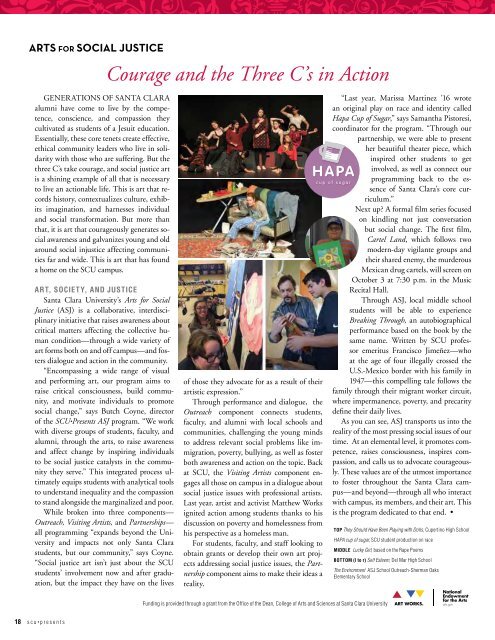SCUpresents2016SoloPgs
Create successful ePaper yourself
Turn your PDF publications into a flip-book with our unique Google optimized e-Paper software.
ARTS FOR SOCIAL JUSTICE<br />
Courage and the Three C’s in Action<br />
GENERATIONS OF SANTA CLARA<br />
alumni have come to live by the competence,<br />
conscience, and compassion they<br />
cultivated as students of a Jesuit education.<br />
Essentially, these core tenets create effective,<br />
ethical community leaders who live in solidarity<br />
with those who are suffering. But the<br />
three C’s take courage, and social justice art<br />
is a shining example of all that is necessary<br />
to live an actionable life. This is art that records<br />
history, contextualizes culture, exhibits<br />
imagination, and harnesses individual<br />
and social transformation. But more than<br />
that, it is art that courageously generates social<br />
awareness and galvanizes young and old<br />
around social injustice affecting communities<br />
far and wide. This is art that has found<br />
a home on the SCU campus.<br />
ART, SOCIETY, AND JUSTICE<br />
Santa Clara University’s Arts for Social<br />
Justice (ASJ) is a collaborative, interdisciplinary<br />
initiative that raises awareness about<br />
critical matters affecting the collective human<br />
condition—through a wide variety of<br />
art forms both on and off campus—and fosters<br />
dialogue and action in the community.<br />
“Encompassing a wide range of visual<br />
and performing art, our program aims to<br />
raise critical consciousness, build community,<br />
and motivate individuals to promote<br />
social change,” says Butch Coyne, director<br />
of the SCU•Presents ASJ program. “We work<br />
with diverse groups of students, faculty, and<br />
alumni, through the arts, to raise awareness<br />
and affect change by inspiring individuals<br />
to be social justice catalysts in the community<br />
they serve.” This integrated process ultimately<br />
equips students with analytical tools<br />
to understand inequality and the compassion<br />
to stand alongside the marginalized and poor.<br />
While broken into three components—<br />
Outreach, Visiting Artists, and Partnerships—<br />
all programming “expands beyond the University<br />
and impacts not only Santa Clara<br />
students, but our community,” says Coyne.<br />
“Social justice art isn’t just about the SCU<br />
students’ involvement now and after graduation,<br />
but the impact they have on the lives<br />
of those they advocate for as a result of their<br />
artistic expression.”<br />
Through performance and dialogue, the<br />
Outreach component connects students,<br />
faculty, and alumni with local schools and<br />
communities, challenging the young minds<br />
to address relevant social problems like immigration,<br />
poverty, bullying, as well as foster<br />
both awareness and action on the topic. Back<br />
at SCU, the Visiting Artists component engages<br />
all those on campus in a dialogue about<br />
social justice issues with professional artists.<br />
Last year, artist and activist Matthew Works<br />
ignited action among students thanks to his<br />
discussion on poverty and homelessness from<br />
his perspective as a homeless man.<br />
For students, faculty, and staff looking to<br />
obtain grants or develop their own art projects<br />
addressing social justice issues, the Partnership<br />
component aims to make their ideas a<br />
reality.<br />
“Last year, Marissa Martinez ’16 wrote<br />
an original play on race and identity called<br />
Hapa Cup of Sugar,” says Samantha Pistoresi,<br />
coordinator for the program. “Through our<br />
partnership, we were able to present<br />
her beautiful theater piece, which<br />
inspired other students to get<br />
involved, as well as connect our<br />
programming back to the essence<br />
of Santa Clara’s core curriculum.”<br />
Next up? A formal film series focused<br />
on kindling not just conversation<br />
but social change. The first film,<br />
Cartel Land, which follows two<br />
modern-day vigilante groups and<br />
their shared enemy, the murderous<br />
Mexican drug cartels, will screen on<br />
October 3 at 7:30 p.m. in the Music<br />
Recital Hall.<br />
Through ASJ, local middle school<br />
students will be able to experience<br />
Breaking Through, an autobiographical<br />
performance based on the book by the<br />
same name. Written by SCU professor<br />
emeritus Francisco Jimeñez—who<br />
at the age of four illegally crossed the<br />
U.S.-Mexico border with his family in<br />
1947—this compelling tale follows the<br />
family through their migrant worker circuit,<br />
where impermanence, poverty, and precarity<br />
define their daily lives.<br />
As you can see, ASJ transports us into the<br />
reality of the most pressing social issues of our<br />
time. At an elemental level, it promotes competence,<br />
raises consciousness, inspires compassion,<br />
and calls us to advocate courageously.<br />
These values are of the utmost importance<br />
to foster throughout the Santa Clara campus—and<br />
beyond—through all who interact<br />
with campus, its members, and their art. This<br />
is the program dedicated to that end. •<br />
TOP They Should Have Been Playing with Dolls, Cupertino High School<br />
HAPA cup of sugar, SCU student production on race<br />
MIDDLE Lucky Girl, based on the Rape Poems<br />
BOTTOM (l to r) Self Esteem, Del Mar High School<br />
The Environment ASJ School Outreach-Sherman Oaks<br />
Elementary School<br />
Funding is provided through a grant from the Office of the Dean, College of Arts and Sciences at Santa Clara University<br />
18 scu • presents


